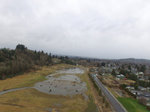



The Chehalis River Basin Flood Authority got good news Thursday during a regular meeting in Olympia — the work and money spent on a local flood-mitigation project has already paid off.
When rains pushed the Skookumchuck and Chehalis rivers out of their banks in the first week of January, China Creek, long one of the area’s worst culprits when it comes to chronic flooding, stayed under control.
“This is your project that you stood behind Centralia and funded,” said Flood Authority staff member Scott Boettcher.
The city of Centralia recently completed phase one of its China Creek project, which created a more natural, meandering path for the creek in the area of Little Hanaford Road. It was intended to decrease flooding in the portion of the creek that flows through downtown Centralia.
The project cost about $2.1 million
Boettcher presented the board with pictures of the results of that work on Thursday, showing water pooling in the curves of the creek off Little Hanaford Road during the flood event. Boettcher said anecdotal evidence showed China Creek was lower than expected in Centralia.
“I think this seems to be tackling the type of flooding that the project was conceived to handle,” he said.
Ron Averill, representing the city of Centralia on the Flood Authority, said the project will only improve with time.
“The vegetation is not mature, and once it matures it’s going to do its job,” he said.
The second phase of the China Creek project will involve the raising of the Angew Mill Ponds near Gold Street that were once used by a large sawmill of the same name. The work is intended to increase the amount of water that can be stored at the ponds.
Phase two is anticipated to cost around $2.4 million and is currently out to bid.
The remainder of Thursday’s meeting of the flood authority included discussions on how the authority could be involved in the work of the Office of the Chehalis Basin, created in 2017 by Gov. Jay Inslee and funded by the Legislature to create a long-term solution for the problem of flooding in the basin. It enhances the local work done by the flood authority.
The office’s Aquatic Species Restoration Plan, released as a draft in November, has gone through the public comment phase and is now in phase two, said Emelie McKain, the project manager with the Washington State Department of Fish and Wildlife.
“We’re taking all of those ideas and comments and bringing them into the next phase of development,” she said.
Phase three, she said, will begin in fall and winter of this year and will involve selecting one strategy for aquatic species restoration in the basin. WDFW is already working with willing landowners to do projects along 2- or 3-mile stretches of the Chehalis River, she said.
“There’s a lot of conversation and a lot of thinking on the landowner’s part … It’s a property by property project as well as a basin-wide look at what is best for restoring the habitat,” said Chehalis Basin Board member J. Vander Stoep, representing Pe Ell as an alternate at the flood authority meeting. “The why is you’ve had a … salmon fishery that’s been in serious decline and the forecast is if you don’t act with climate change it gets worse almost to extinction.”
The spring Chinook run is in particular danger, he said.
Board member Jay Gordon said the spring Chinook run in the Newaukum River is in trouble, and agencies were worried about getting an endangered species listing.
“We’ve got a crisis in the spring Chinook right now,” he said.